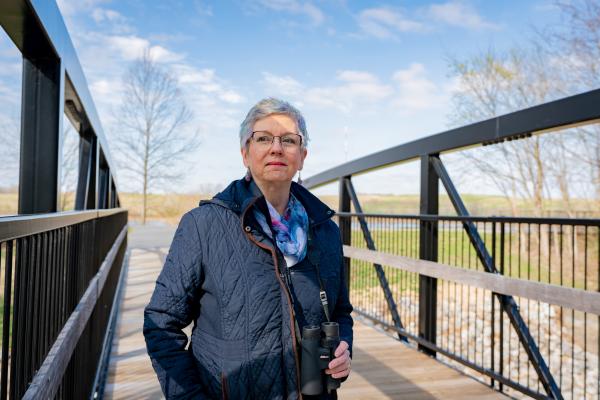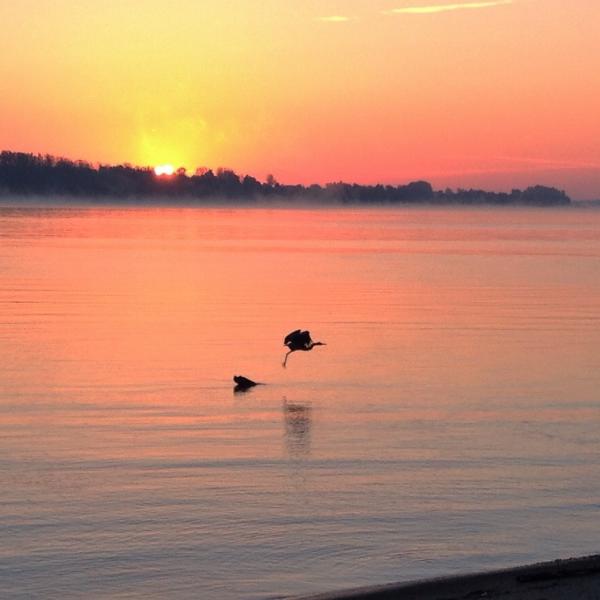The Paducah Convention & Visitors Bureau is excited to partner with Paducah Life Magazine to feature articles like this one.
Offering spectacular views and riverside breezes, Paducah is a bird-watcher's ideal spot for practicing this time-tested hobby. Read about local entrepreneur Susan Edwards' favorite bird-watching tips and trips for making the most of your time in Paducah and the surrounding area.

Susan scans the treetops for local wildlife at Paducah's Greenway Trail.
One of Susan Edwards’s prized pastimes has been a lifelong hobby since she was 16 years old. A licensed spiritual healer coach, author, public speaker, and owner of Paducah’s downtown Rock Shop, Susan K. Edwards enjoys birdwatching as a getaway to spend time with nature and relax. “I probably bird watch 50% of the time by myself. I have a bird bag with my binoculars, pen, three by five spiral notepad, and field guide, and when I just need to get away from everybody, I’ll grab my bag, park somewhere like Noble Park or The Greenway Trail, travel the path, and hang out with nature.” At Noble Park, the Peck Education Trail is a wooded, half-mile nature walk with boardwalks, benches, and a switchback that connects to a nature trail. It’s a perfect area for birdwatching. The Greenway Trail extends more than five miles linking residential neighborhoods with several city parks, the McCracken County trail system, and the riverfront—a prime waterfowl watcher spot.
Rivers are an irresistible draw for birds, so the confluence of the Ohio and Tennessee rivers at the base of Broadway is the perfect place to start bird watching. The Greenway Trail links Perkins Creek Nature Preserve—approximately 80 acres of undeveloped natural land on the west side of Paducah— to Stuart Nelson Park, Noble Park, and Schultz Park. Look for nesting woodland birds on the Greenway Trail. You’ll be surprised by the variety and number of species in this area, says Susan, such as chickadees, dark-eyed juncos, European starlings, red-winged blackbirds, mourning doves, eastern towhees, song sparrows, Carolina wrens, tufted titmice, Carolina chickadees, and down woodpeckers.
Susan calls downtown Paducah a true treasure trove for bird watching, even in the winter months. Bird watchers can find ring-billed gulls, fish crows, white-throated sparrows, cardinals, and mockingbirds, along with more exotic species like bald eagles and migrating white pelicans as they follow their seasonal migration routes.

Rivers are an irresistible draw for birds, so the confluence of the Ohio and Tennessee rivers at the base of Broadway is the perfect place to start bird watching.
No matter what the season, there are always interesting birds to see at The Nature Conservancy’s Kentucky nature preserve as well. In fact, birds move through Kentucky all year long. Some change habitats within state borders; others stop by during spring and fall as part of long journeys between breeding grounds and warmer climates.
Susan’s favorite place to go birdwatching is Mermet Lake State Fish and Wildlife Area, an old cypress southern Illinois swamp managed as one of the state’s most outstanding waterfowl hunting locales, about 30 minutes from Paducah.“It’s a one-way driving trail around a three-acre lake,” Susan indicated,“or you can park and walk and see one side—the lake—or the other side—a drainage ditch and forest. We see so much there! My husband and I go at least once a month and probably have at least 15 years of data from that spot.” If she sees a bird, Susan scores this in her spiral. She simply lists what she sees—a starling, a sparrow, or a chickadee. It’s not a scientific listing, but simply a record of what she saw that day. She even extends beyond birds, noting appearances of snakes, turtles, beavers, and even a multitude of muskrats she met at Mermet. People can do that with their backyard birds, too.“It’s fun to look back,” she reflected. “I have noticed patterns. For example, I haven’t seen bald eagles in the last six months at Mermet and I had been seeing them a lot. The golden eagle used to be there and we once could see them while driving. I have even seen a reduction in songbirds in general, just in my backyard.”

Susan calls downtown Paducah a true treasure trove for bird watching, even in the winter months.
All you really need to be a birdwatcher are your two eyes and ears. You don’t need fancy or expensive equipment. You can just go out and look for birds. But Susan admits it’s handy to have an affordable pair of binoculars and a field guide showing where you can find birds and what they look like, which you can pick up for well under $20. Or you can download free apps on your phone such as iBird and the Audubon Bird Guide to help identify species. Phones assist with taking quick photos of birds needing identification. Taking birdwatching notes is also a fun form of journaling, says Susan. Additionally, you can download and print a free birding checklist from the Land Between the Lakes website.
Besides looking at birds, you might be curious to learn their sounds and songs. If you hear, but don’t see, birds in your backyard, you can listen and identify them by purchasing an app like Larkwire. Learn Bird ID or the Chirp! app.
“We share this earth with many other species, both plant and animals,” says Susan.“Making a connection spiritually and enjoying another species like birds helps you feel a part of nature, connected, and responsible to be a good steward. Even something as simple as planting native plants and trees in your yard will provide food and shelter for local birds and wildlife. I find it relaxing and fascinating, one of those hobbies that is easy to do and you can do it as formally or informally as you want.”
